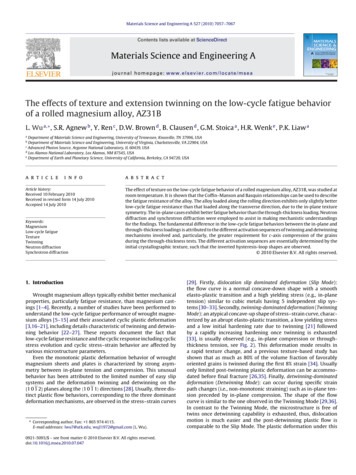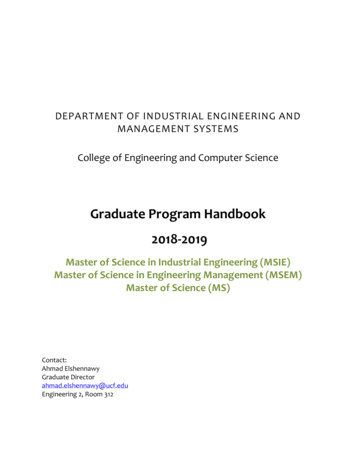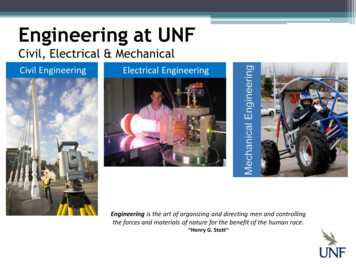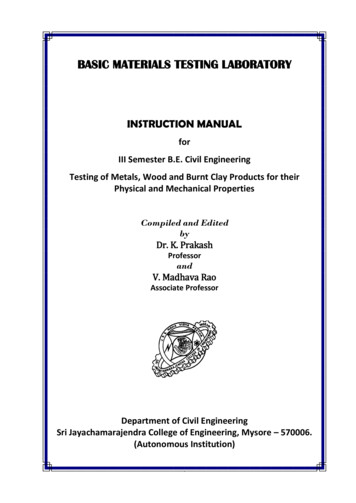
Transcription
Materials Science and Engineering A 527 (2010) 7057–7067Contents lists available at ScienceDirectMaterials Science and Engineering Ajournal homepage: www.elsevier.com/locate/mseaThe effects of texture and extension twinning on the low-cycle fatigue behaviorof a rolled magnesium alloy, AZ31BL. Wu a, , S.R. Agnew b , Y. Ren c , D.W. Brown d , B. Clausen d , G.M. Stoica a , H.R. Wenk e , P.K. Liaw aaDepartment of Materials Science and Engineering, University of Tennessee, Knoxville, TN 37996, USADepartment of Materials Science and Engineering, University of Virginia, Charlottesville, VA 22904, USAAdvanced Photon Source, Argonne National Laboratory, IL 60439, USAdLos Alamos National Laboratory, Los Alamos, NM 87545, USAeDepartment of Earth and Planetary Science, University of California, Berkeley, CA 94720, USAbca r t i c l ei n f oArticle history:Received 10 February 2010Received in revised form 14 July 2010Accepted 14 July 2010Keywords:MagnesiumLow-cycle fatigueTextureTwinningNeutron diffractionSynchrotron diffractiona b s t r a c tThe effect of texture on the low-cycle fatigue behavior of a rolled magnesium alloy, AZ31B, was studied atroom temperature. It is shown that the Coffin–Manson and Basquin relationships can be used to describethe fatigue resistance of the alloy. The alloy loaded along the rolling direction exhibits only slightly betterlow-cycle fatigue resistance than that loaded along the transverse direction, due to the in-plane texturesymmetry. The in-plane cases exhibit better fatigue behavior than the through-thickness loading. Neutrondiffraction and synchrotron diffraction were employed to assist in making mechanistic understandingsfor the findings. The fundamental difference in the low-cycle fatigue behaviors between the in-plane andthrough-thickness loadings is attributed to the different activation sequences of twinning and detwinningmechanisms involved and, particularly, the greater requirement for c-axis compression of the grainsduring the through-thickness tests. The different activation sequences are essentially determined by theinitial crystallographic texture, such that the inverted hysteresis-loop shapes are observed. 2010 Elsevier B.V. All rights reserved.1. IntroductionWrought magnesium alloys typically exhibit better mechanicalproperties, particularly fatigue resistance, than magnesium castings [1–4]. Recently, a number of studies have been performed tounderstand the low-cycle fatigue performance of wrought magnesium alloys [5–15] and their associated cyclic plastic deformation[3,16–21], including details characteristic of twinning and detwinning behavior [22–27]. These reports document the fact thatlow-cycle fatigue resistance and the cyclic response including cyclicstress evolution and cyclic stress–strain behavior are affected byvarious microstructure parameters.Even the monotonic plastic deformation behavior of wroughtmagnesium sheets and plates is characterized by strong asymmetry between in-plane tension and compression. This unusualbehavior has been attributed to the limited number of easy slipsystems and the deformation twinning and detwinning on the{1 0 1 2} planes along the 1 0 1 1 directions [28]. Usually, three distinct plastic flow behaviors, corresponding to the three dominantdeformation mechanisms, are observed in the stress–strain curves Corresponding author. Fax: 1 865 974 4115.E-mail addresses: lwu7@utk.edu, wujl1972@gmail.com (L. Wu).0921-5093/ – see front matter 2010 Elsevier B.V. All rights reserved.doi:10.1016/j.msea.2010.07.047[29]. Firstly, dislocation slip dominated deformation (Slip Mode):the flow curve is a normal concave-down shape with a smoothelasto-plastic transition and a high yielding stress (e.g., in-planetension) similar to cubic metals having 5 independent slip systems [30–33]. Secondly, twinning-dominated deformation (TwinningMode): an atypical concave-up shape of stress–strain curve, characterized by an abrupt elasto-plastic transition, a low yielding stressand a low initial hardening rate due to twinning [21] followedby a rapidly increasing hardening once twinning is exhausted[33], is usually observed (e.g., in-plane compression or throughthickness tension, see Fig. 2). This deformation mode results ina rapid texture change, and a previous texture-based study hasshown that as much as 80% of the volume fraction of favorablyoriented grains is twinned during the first 8% strain [34]. Usuallyonly limited post-twinning plastic deformation can be accommodated before final fracture [26,35]. Finally, detwinning-dominateddeformation (Detwinning Mode): can occur during specific strainpath changes (i.e., non-monotonic straining) such as in-plane tension preceded by in-plane compression. The shape of the flowcurve is similar to the one observed in the Twinning Mode [29,36].In contrast to the Twinning Mode, the microstructure is free oftwins once detwinning capability is exhausted, thus, dislocationmotion is much easier and the post-detwinning plastic flow iscomparable to the Slip Mode. The plastic deformation under this
7058L. Wu et al. / Materials Science and Engineering A 527 (2010) 7057–7067mode results in a complete texture reversal due to detwinning[3].The purpose of the current work is to experimentally studythe low-cycle fatigue behavior of the rolled magnesium alloy,AZ31B, loaded along the three orthogonal directions, in order toobtain reliable and useful data regarding the effects of initial texture and extension twinning. Neutron diffraction and synchrotrondiffraction were employed to assist in developing mechanisticexplanations for the findings related to the low-cycle fatigue behavior including: (i) strangely shaped hysteresis loops (Section 4.1), (ii)cyclic stress variation (Section 4.2), and (iii) texture-dependency ofthe low-cycle fatigue resistance (Section 4.3).2. Experimental material and procedures2.1. Experimental materialThe samples used in the current study were cut from a commercially rolled plate of magnesium alloy, AZ31B, with H24 temper(strain hardened and partially annealed). The magnesium alloy hasa nominal composition of 3.0% Al, 1.0% Zn, 0.2% Mn (weight percentage), and Mg as balance. The initial crystallographic textureis presented in Fig. 1. This is a typical rolling texture, most grainsare oriented with their basal (0 0 2) planes parallel to the plate,and the prismatic (1 0 0) poles are essentially distributed randomlywithin the plate plane. Metallographic specimens were preparedusing standard techniques, finishing with 1 m diamond paste inmethanol. Acetic picral solution (4.2 g picric acid, 10 ml acetic acid,10 ml water, and 70 ml ethanol) was employed to etch the specimens for 30–50 s, which revealed grains and/or twins under opticalmicroscopy. The initial grain size was revealed to be 15 m andthe initial twin volume fraction was low.2.2. Low-cycle fatigue experiments and metallographicobservationsCylindrical fatigue specimens, with a gauge length of 6.35 mmand a gauge diameter of 2.92 mm, were machined from the rolledmagnesium alloy, AZ31B, with their loading axes, respectively, parallel to the rolling (RD), transverse (TD), and normal (ND) directionsof the plate. Prior to designing the fatigue tests themselves, themonotonic mechanical response of the as-received alloy was characterized under tension and compression loaded along the RD, TD,and ND. Low-cycle fatigue tests were conducted under total straincontrol mode at room temperature, using a servohydraulic Material Test System (MTS 810) equipped with a TestStar IIs controller.A triangular waveform and with fully reversed total strain amplitudes ranging from 0.4% to 3.0% were imposed using a miniatureMTS extensometer at a cyclic frequency of 0.5 Hz. All fatigue tests,where at least two specimens were used at each given strain amplitude, were run until there was a 50% drop in the maximum tensilestresses or actual separation of the specimens. The correspondingnumber of cycles was defined as the low-cycle fatigue life, i.e., theFig. 1. Initial texture for the as-received strain-free AZ31B sample. Measuredcrystallographic texture using ex situ synchrotron diffraction. Pole densities areexpressed in multiples of a random distribution (mrd).number of cycles to failure, Nf . In order to analyze the microstructures at various strain states by optical microscopy, the specimenswere sectioned parallel to the loading axis and prepared metallographically, as described above.2.3. In situ neutron scatteringIn situ neutron measurements were conducted on the Spectrometer for Materials Research at Temperature and Stress (SMARTS)located at the Los Alamos Neutron Science Center (LANSCE), onlyfor the sample with the loading axis parallel to the RD. The experimental details are similar to those presented elsewhere [34,37,38].The cyclic loading was performed using the customized Instronload frame under conditions of fully reversed strain control withtotal strain amplitude of 3.0%. Again, a triangular waveform at a frequency of 0.5 Hz was enforced using an extensometer attached tothe gauge section for feedback. A threaded-end cylindrical sample,having a 19.05 mm gauge section and 6.35 mm diameter, considerably larger than the other samples used in the current study, wasmounted in the horizontal load frame. The diffraction data werecollected at various cycles during the fatigue experiment: 1, 2, 5,10, 20, and 35 cycles. During the first and the second cycle, thediffraction patterns were recorded at 0.5% and 1.0% strain intervals,respectively, while for all other cycles, only six selected points atthe maximum strains, zero strains, or zero stresses were monitored(also see Fig. 2 in Ref. [39]).The polychromatic neutron beam allows to record all possiblelattice planes (effective d-space range from 0.03 to 0.4 nm), withtheir reflecting plane normals (scattering vectors) parallel or perpendicular to the loading axis in the diffraction plane. The twodetector banks situated at 90 simultaneously record the complete diffraction patterns with diffraction vectors parallel (Q ) andperpendicular (Q ) to the loading axis, which is oriented at 45 relative to the incident beam. Both detector banks have acceptance angles of 5.5 in the vertical and horizontal directions. TheND direction of the sample was carefully aligned in the horizontal plane, so that a large volume of grains have their c-axes initiallytransverse to the loading direction, while very few grains have theirbasal poles initially parallel to the loading axis [20,21]. Consideringthe reorientation ( 90 ) of the basal poles within twin grains, relative to the matrix grains, to be thus aligned with the loading axis,the twin grains can be monitored by the same peak in the parallelbank. The experimental configuration, coupled with the reorientation due to extension twinning and the initial sharp basal texturein magnesium alloys, provides a unique opportunity to study thecondition of the parent and twin grains separately [20].2.4. Ex situ texture measurements using synchrotron diffractionHigh energy synchrotron X-rays provide a high penetrationdepth combined with excellent brilliance, so that texture measurements can be carried out in transmission geometry on bulk samples[40]. This eliminates spurious surface effects often present in texture measurements with conventional laboratory X-ray source orelectron backscattering (EBSD) and provides a better statisticalaverage of the microstructure. By employing transmission geometry with an area detector, full Debye–Scherrer rings are recordedsimultaneously such that a significant reduction of measuring timeis obtained [41]. This improvement in temporal resolution makessynchrotron X-rays attractive for in situ texture measurements [40],although this capability was not exploited in the present study.Threaded-end cylindrical samples, having the previouslydescribed sample geometry for low-cycle fatigue testings, wereprepared beforehand at the home lab with the strain amplitudeof 3.0%, as described earlier in Section 2.2. Thus, many different strained samples were used to explore the texture evolution
L. Wu et al. / Materials Science and Engineering A 527 (2010) 7057–7067ex situ at various strain/stress points along the hysteresis loop ofthe first deformation cycle for each of the three loading directions (RD, TD, ND.) These measurements were conducted at theAdvanced Photon Source (APS) of the Argonne National Laboratory, on the high energy beamline 11-ID-C with a monochromaticwavelength of 0.10748 Å, a beam size of 0.5 mm 0.5 mm, and asimple goniometer, on which the strained sample was mountedwith the loading axis aligned vertically for each measurement [41].The sample-to-detector distance (1528.9 mm) and the detector tiltwere calibrated with a CeO2 standard taken prior to the experiments. The sample was rotated around the vertical loading axis(perpendicular to the beam) through 90 in 10 interval to increasethe pole figure coverage. At each position, the sample is irradiatedand the Debye–Scherrer rings are collected using a 3450 3450image-plate detector. The exposure time for each image was 30 s.The Materials Analysis Using Diffraction (MAUD) software [42]was used to perform texture analysis via Rietveld method, whichrefines the whole diffraction pattern based on the crystallographicstructure including lattice parameters [43,44]. For the detailsregarding the data reduction and texture analysis using MAUD,please refer to the papers by Miyagi et al. [45] and Lonardelli etal. [41].3. Experimental results3.1. Monotonic stress–strain behaviorFig. 2 illustrates that the tension-compression yielding asymmetry and the high anisotropy of plastic flow are evident. If thesamples are loaded along the RD and TD directions, the compressiveflow curves (respectively, labeled as “RD-C” and “TD-C” in Fig. 2)exhibit the similar features resulting from the in-plane texturesymmetry. The stress–strain curves show an concave-up shape,characterized by an abrupt elasto-plastic transition, a low yielding stress, and an initial low hardening rate followed by a rapidlyincreasing hardening. This behavior is characteristic of the Twinning Mode discussed in Section 1 previously. In contrast, the tensileflow curves (respectively, labeled as “RD-T” and “TD-T”) show thenormal, concave-down shapes with typical features of the SlipMode. If, on the other hand, the sample is loaded along the ND direction (labeled as “ND-T”), which, correspondingly, loads the grainscomposing the major texture component along the c-axes of thehexagonal-close-packed lattice because of the strong basal textureFig. 2. The monotonic mechanical responses loaded, respectively, along the RD, TDand ND directions both under compression (C) and tension (T) of AZ31B alloy. Solidlines for tension, and dashed lines for compression.7059(Fig. 1), the tensile curve has a concave-up shape, characteristic ofthe activation of extension twinning. Under compression, the NDsample has a much higher flow stress and very little ductility ( 5%),due to the fact that both basal and prismatic a slips are unableto accommodate inelastic shape change along the c-axis, and the c a pyramidal slip and contraction twinning seem to result inshear instability at room temperature.If the plastic deformation is initially accommodated by extension twinning, the similar yielding stresses ( 100 MPa) areobserved. This demonstrates that the yielding stresses are notrelated to the strain direction (or sign) if the extension twinningis the dominating plastic deformation mechanism. In contrast, theyielding stresses are usually different with respect to the loadingdirections due to the difference of Schmid factor, if the dislocationslips are dominant throughout the plastic deformation. The monotonic mechanical properties serve as a basis for further performingthe cyclic deformation and low-cycle fatigue studies.3.2. Low-cycle fatigue behaviorLow-cycle fatigue behavior under the RD loading: The fatigue lifedata under the RD loading, i.e., various strain amplitudes (elastic strain and plastic strain) vs. number of reversals to failure,are shown in Fig. 3a. The dashed line shows that the low-cyclefatigue resistances can be predicted by the combined Basquin andCoffin–Manson equations. All symbols represent the experimentaldata taken from the half-life hysteresis loops, and the solid linesare the best linear fits obtained using linear regression analysis. Ingeneral, the Coffin–Manson and Basquin laws [46] can be used torelate the plastic and elastic strain amplitude, respectively, to thereversals to failure. The cyclic stress–strain curve shown in Fig. 3b iswell described by the Holloman relation [46]. The coefficients andexponents in the Basquin, Coffin–Manson, and Holloman equationsare listed in Table 1.The analysis of the stress–strain hysteresis loops can giveus more insights into the cyclic deformation behavior. Fig. 3cillustrates the stress–strain hysteresis loops at different strainamplitudes under the RD loading, which are obtained at the half-lifecycles. The pronounced asymmetric deformation behavior undertension and compression is observed. At the lowest strain amplitude of 0.4%, the asymmetry of the hysteresis loop is not so obvious,where it can be readily understood that the strain is accommodated mainly by elastic deformation. As the total strain amplitudeincreases (from 0.6% to 2.0%), the asymmetry between tension andcompression becomes more and more significant. The tensile peakstress is significantly higher than the compressive one, resulting in atensile mean stress for these strain amplitude controlled tests. Thistension-compression asymmetry is attributed to the fundamental difference of deformation modes, where twinning dominatescompression, while detwinning is active under subsequent unloading and tensile reloading. If the total strain amplitude is imposedwith 3.0% strain, the asymmetry of the hysteresis loop is reducedwith a decreased difference observed between the peak and valleystresses. These mechanisms will be discussed in detail below, basedon the lattice reorientation of the (0 0 2) basal planes from the in situneutron scattering and the ex situ synchrotron texture evolution.The variation of stress response with fatigue cycles (Nf ) is animportant feature of the low-cycle fatigue process and is presentedin Fig. 3d. The cyclic stress response, which was determined bymonitoring the stress response during total strain amplitude controlled fatigue, provides useful information pertaining to the cyclicstability of the material. At all tested strain amplitudes, the alloyshows a continuous cyclic compressive hardening behavior. Thisseems to be related to the gradually increased maximum volumefraction of twins in the material during the cyclic deformation, assuggested by the in situ neutron scattering below. The cyclic tensile
7060L. Wu et al. / Materials Science and Engineering A 527 (2010) 7057–7067Fig. 3. The low-cycle fatigue behavior of the as-rolled AZ31B alloy under the RD loading: (a) ε–N fatigue life curves; (b) cyclic stress and strain curves; (c) hysteresis loops athalf-life for various total strain amplitudes; and (d) cyclic tensile and compressive peak stress responses.stress response is more complicated. At the low total strain amplitudes of 0.4% and 0.6%, the alloy exhibits a continuous cyclic tensilestrain hardening until a sharp stress drop before final failure. Forthe moderate applied total strain amplitudes of 1.0% and 1.4%, thetensile peak stress initially shows cyclic hardening, then cyclic softening, and finally cyclic hardening again before final abrupt stressdrop. This complicated evolution is not currently well understood.As the total strain amplitude is increased to 2.0% and 3.0%, the cyclictensile stress hardening during the second cycle, and, thereafter,cyclic tensile stress softening is observed. This cyclic stress responsewill be further discussed, based on the in situ neutron study duringthe cyclic deformation.Low-cycle fatigue behavior under the TD loading: Fig. 4 shows thelow-cycle fatigue behavior under the TD loading analogous to thatunder the RD loading, indicating that the overall behavior underthe TD loading is similar to that under the RD loading, althoughthere are subtle differences. The overall similarity is expected andattributed to the in-plane texture symmetry.Low-cycle fatigue behavior under the ND loading: Fig. 5 represents the low-cycle fatigue behavior under the ND loading: (a)ε N fatigue life curves, (b) cyclic stress–strain curves, (c) hysteresisloops at half-life for various total strain amplitudes, and (d) cyclictensile and compressive stress responses. The data in Fig. 5a follow the Coffin–Manson and Basquin relationships, as under the RDTable 1Fitted low-cycle fatigue parameters for the as-rolled AZ31B alloy loaded, respectively, along the RD, TD, and ND directions, based on the Basquin, Coffin–Manson, andHolloman equations. The “all” column lists the parameters fitted from the combined data from all directions.ParametersLoading directionsRDCoffin–MansonεfcR2Basquin f , MPabR2HollomanK , MPanR2TDNDAll1.54 0.530.59 0.250.36 0.070.75 0.030.90 0.050.98740.78 0.070.96750.70 0.030.98880.78 0.030.9755693.04 126.84686.12 87.631361.29 208.73921.26 99.860.15 0.030.89990.16 0.020.9443375.20 32.180.11 0.010.9365393.04 13.700.13 0.010.99100.26 0.020.86620.21 0.020.9071731.48 75.640.25 0.020.9638471.32 43.310.16 0.020.8666
L. Wu et al. / Materials Science and Engineering A 527 (2010) 7057–70677061Fig. 4. The low-cycle fatigue behavior of the as-rolled AZ31B alloy under the TD loading: (a) ε–N fatigue life curves; (b) cyclic stress and strain curves; (c) hysteresis loops athalf-life for various total strain amplitudes; and (d) cyclic tensile and compressive peak stress responses.loading, and the cyclic stress amplitude with respect to the plasticstrain amplitude (Fig. 5b) follows the Holloman relation.Fig. 5c shows the hysteresis loops at half-life cycle for various total strain amplitudes. The shapes of the hysteresis loops,at the high strain amplitudes above 0.6% strain, are distinct fromthose in Figs. 3c and 4c, indicating different plastic deformationmechanisms, respectively, involved in the compression and tension. Compared to those in Figs. 3c and 4c, it is reasonably assumedthat during the tensile cycles the alloy undergoes twinning, whiledetwinning dominates the subsequent unloadings and compressive reloadings. This assumption will be corroborated by the ex situtexture evolution measured by synchrotron diffraction below. Incontrast to the tensile mean stress in the RD and TD loadings, acompressive mean stress is obtained in this case. Fig. 5d representsthe cyclic tensile and compressive peak stress responses at varioustotal strain amplitudes. It is obvious that both the tensile stress andcompressive stress increase continuously with cycling, regardlessof total strain amplitude.Comparison between the three loading directions: The preceding discussion has shown that the low-cycle fatigue propertiescan be well described and predicted by the well-known Basquin,Coffin–Manson, and Holloman equations for all loading directions.The alloy tested under the RD loading exhibits the best low-cyclefatigue property, yet it is quite comparable to the TD loading, asmanifested in Fig. 6. However, at almost every total strain amplitude, the ND loading shows the lowest low-cycle fatigue resistance.This phenomenon, that the low-cycle fatigue property is closelyrelated to the loading direction, is called texture-dependency inthe current study.4. Discussions4.1. Strangely shaped hysteresis loops due to cyclic twinning anddetwinningFig. 7 shows the hysteresis loops, at the first, second and half-lifecycles with a cyclic strain amplitude of 3.0%, loaded along the RDdirection. Fig. 8 shows the normalized intensity evolution of basal(0 0 2) poles, measured using in situ neutron scattering as a functionof strains (or cycles), providing the cyclic microstructural evolutionduring the whole fatigue life span.The similar characterization has been made to the hysteresisloops, and the cyclic twinning and detwinning phenomena forthe extruded magnesium alloy, ZK60A, during the cyclic deformation loaded along the extrusion direction, though at a lower strainamplitude of 1.2% [21]. Only a brief description is needed here inorder to illustrate the low-cycle fatigue behavior. The asymmetrichysteresis loops with a sigmoidal shape in Fig. 7 are characteristic of mechanical twinning and detwinning in magnesium alloys[16,18–21]. After the initial compressive yielding at 0.4%, thealloy shows little stress hardening. The intensity of the basal (0 0 2)poles in the RD direction in Fig. 8, gradually increases, while thecorresponding intensity in the ND direction decreases. This suggests that extension twinning is active upon compressive yielding,the parent grains begin to be gradually reoriented, and more andmore twins are progressively formed.Upon reversal, the stress–strain response departs from the linear elastic compressive unloading almost immediately, indicatingsome plastic dissipation (i.e., Bauschinger effect) due to the partial
7062L. Wu et al. / Materials Science and Engineering A 527 (2010) 7057–7067Fig. 5. The low-cycle fatigue behavior of the as-rolled AZ31B alloy under the ND loading: (a) ε–N fatigue life curves; (b) cyclic stress and strain curves; (c) hysteresis loopsat half-life for various total strain amplitudes; and (d) cyclic tensile and compressive peak stress responses.reversal of twins. It has been demonstrated that the detwinningevent during unloading is driven by the local tensile stress resultedfrom the stress redistribution between the different grain orientations [20,47]. Correspondingly, as soon as the straining is reversed,the (0 0 2) intensity in the RD direction begins decreasing. The(0 0 2) intensity in the RD direction, indicative of the twin volumefraction, continues to decrease all the way back to the backgrounduntil the plastic compressive strain is recovered at 0%. Concur-Fig. 6. Total strain amplitudes as a function of the number of reversals to failure,respectively, loaded along the three orthogonal directions in the extruded AZ31Balloy.rently, the basal intensity in the ND direction is almost recovered.This result suggests that the twin grains formed during the initialcompression are entirely removed by detwinning, where an inflection point is observed on the hysteresis loop, and beyond the point,the stress hardening rate rapidly increases. Beyond this point, thedeformation is accommodated by the elasticity [18] or the harderdislocation slips [21,48], which result in a higher strain harden-Fig. 7. Hysteresis loops, respectively, for the first cycle, second cycle and the half-lifecycle loaded along the RD direction with a strain amplitude of 3.0%.
L. Wu et al. / Materials Science and Engineering A 527 (2010) 7057–70677063This is the possible reason that the asymmetry is reduced and continues to diminish with cycling at this high strain amplitude (Fig. 3cand d).Similarly, the inflection point on the tensile side of the hysteresis loops is delayed to a larger and larger strain level (Fig. 7), and,thus, the strain recovery by detwinning is continuously delayedto higher strain levels (Fig. 8). The strain at which the hysteresis loop inflects is important because it is only beyond this pointthat the strain hardening rapidly increases, and the cyclic softening observed on the tensile side of the hysteresis loops at the secondcycle, thereafter, is most probably related to the decreasing amountof the post-detwinning dislocation-based flow in the parent grains.4.3. Texture-dependency of the low-cycle fatigue behavior due tothe difference in cyclic plastic deformationFig. 8. The intensity evolutions as a function of the applied engineering strains dueto the activation of the extension twinning under the cyclic deformation with astrain amplitude of 3.0% loaded along the RD direction.ing rate up to the maximum tensile stress, but they do not yield arapid lattice reorientation, thus the (0 0 2) peak intensity remainsunchanged during this portion of the hysteresis loop.During the unloading from the maximum tensile strain, the(0 0 2) pole intensity is equal to the background intensity throughthe zero stress until the plastic deformation begins once againduring the second compression stroke at 1.8% (Fig. 7), thus,the intensity for the ND direction starts increasing again (Fig. 8).Because the second compressive straining induces more plasticstrains than that in the first cycle, a large volume fraction of twinsare formed. Consequently, the maximum intensity is higher at theend of the second compressive cycle than that of the first cycle.During the second tensile reversal, a large volume fraction of twinsis available to be detwinned. As a result, more tensile strains can beaccommodated by detwinning, exhibited as the later appearance ofthe inflection point at 1.8%. This observation is confirmed by thefact that the (0 0 2) peak intensity in RD direction does not returnclose to the background level at 0% strain as in the first cycle.The subsequent hysteresis loops closely follow the shape ofthe second cycle, except that the cyclic peak compressive stressexhibits an ever increasing hardening rate during the later cycles,while the cyclic tensile stress shows a softening behavior. Thecurrently observed strangely shaped hysteresis loops can then beexplained by the cyclic twinning and detwinning mechanisms.4.2. Cyclic stress variation due to the ever increasing amount oftwinsAs discussed in the previous report [21], the continuouslyincreasing intensity of the basal (0 0 2) poles in the RD direction andthe corresponding decreasing in the ND direction at the maximumcompressive strain suggest that the presence of an ever increasingvolume
7058 L. Wu et al. / Materials Science and Engineering A 527 (2010) 7057–7067 mode results in a complete texture reversal due to detwinning [3]. T











